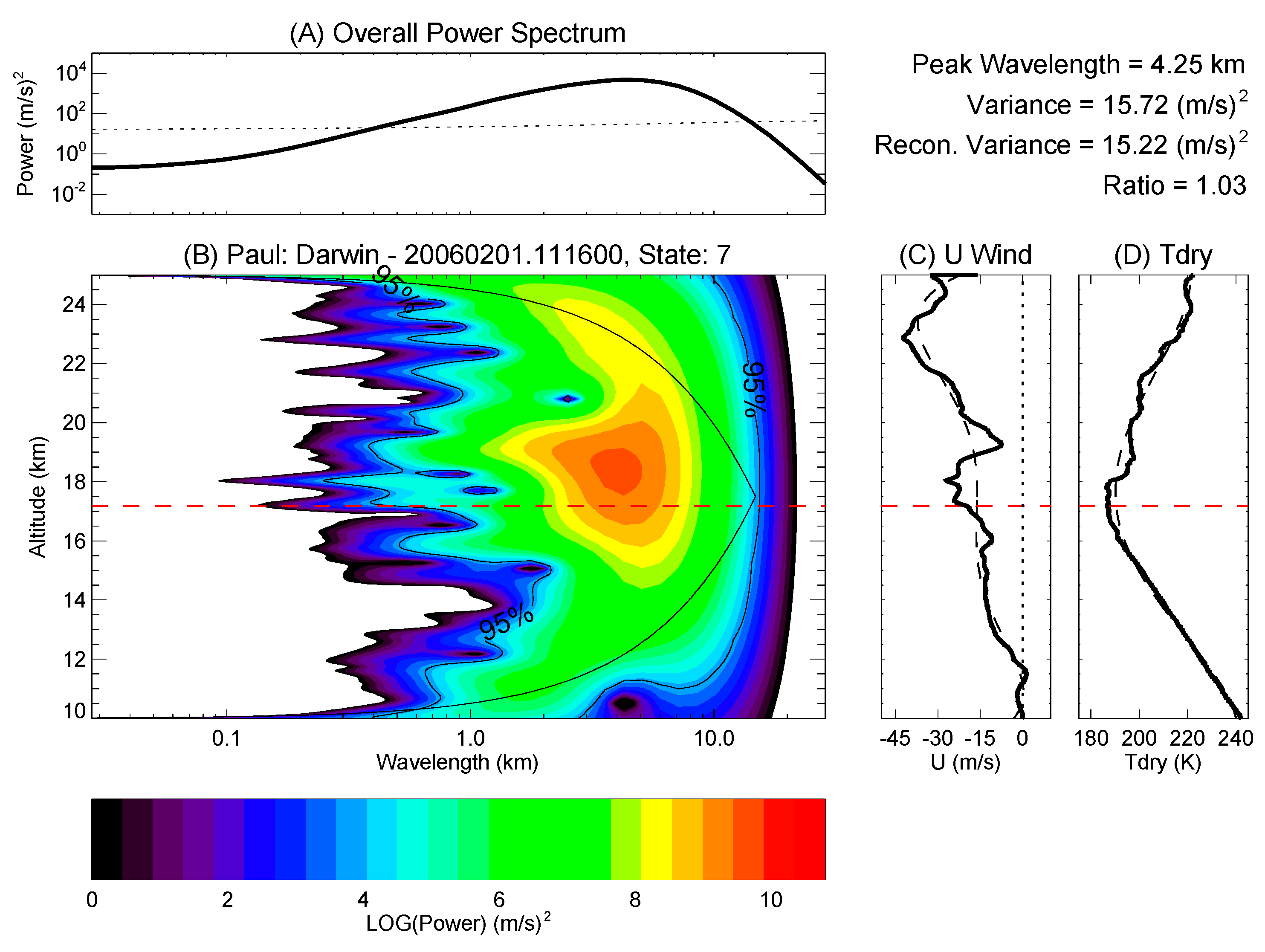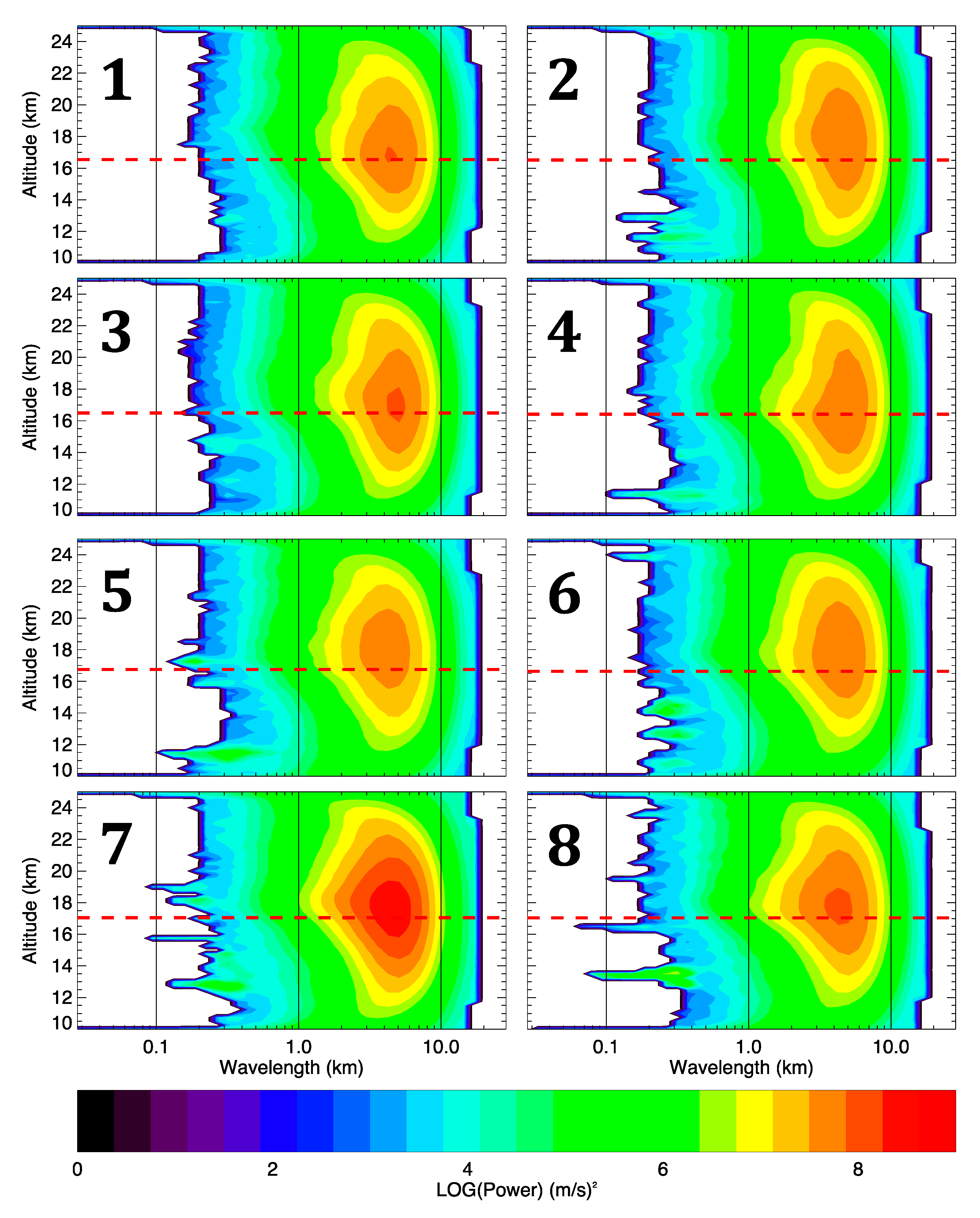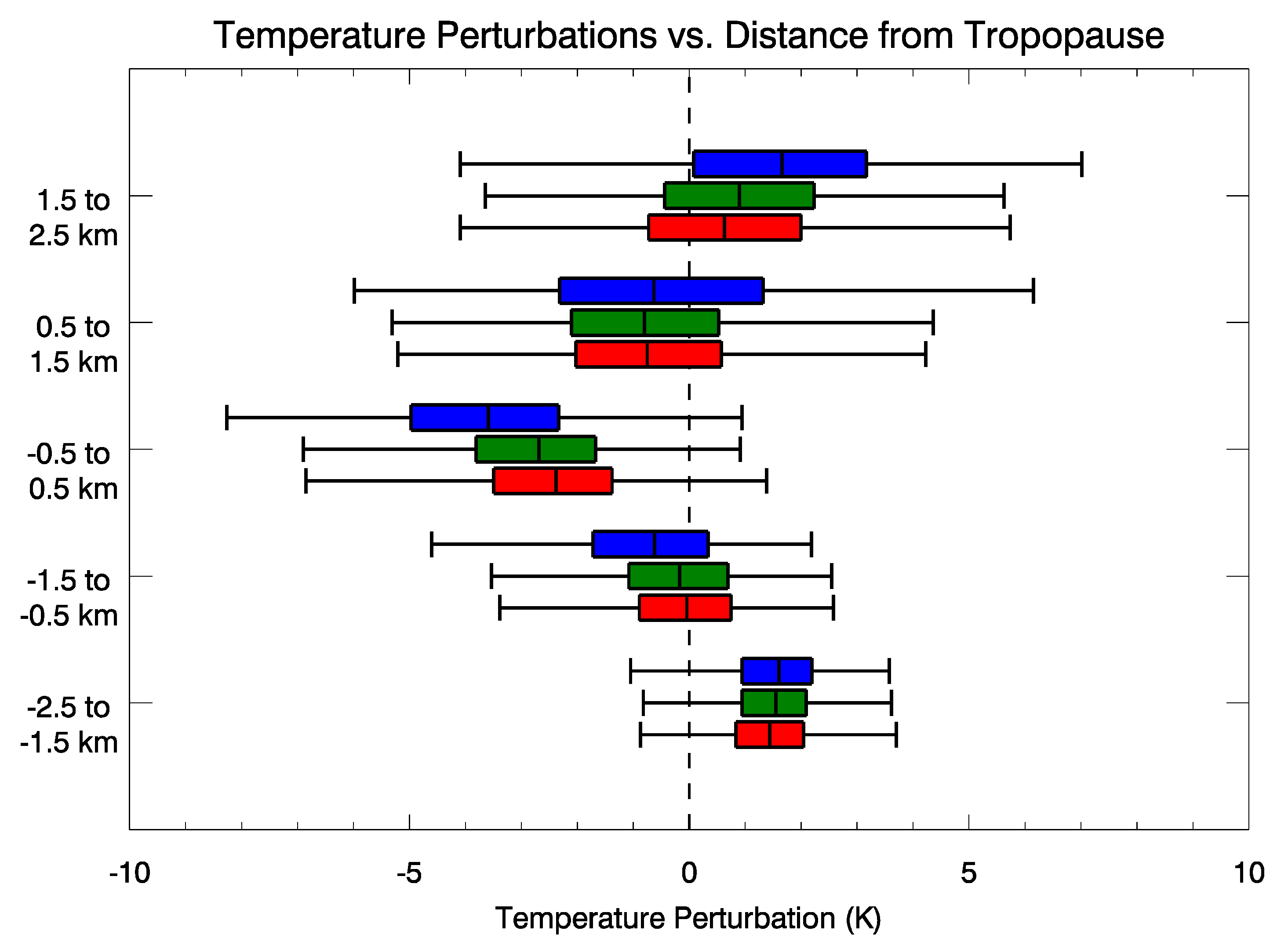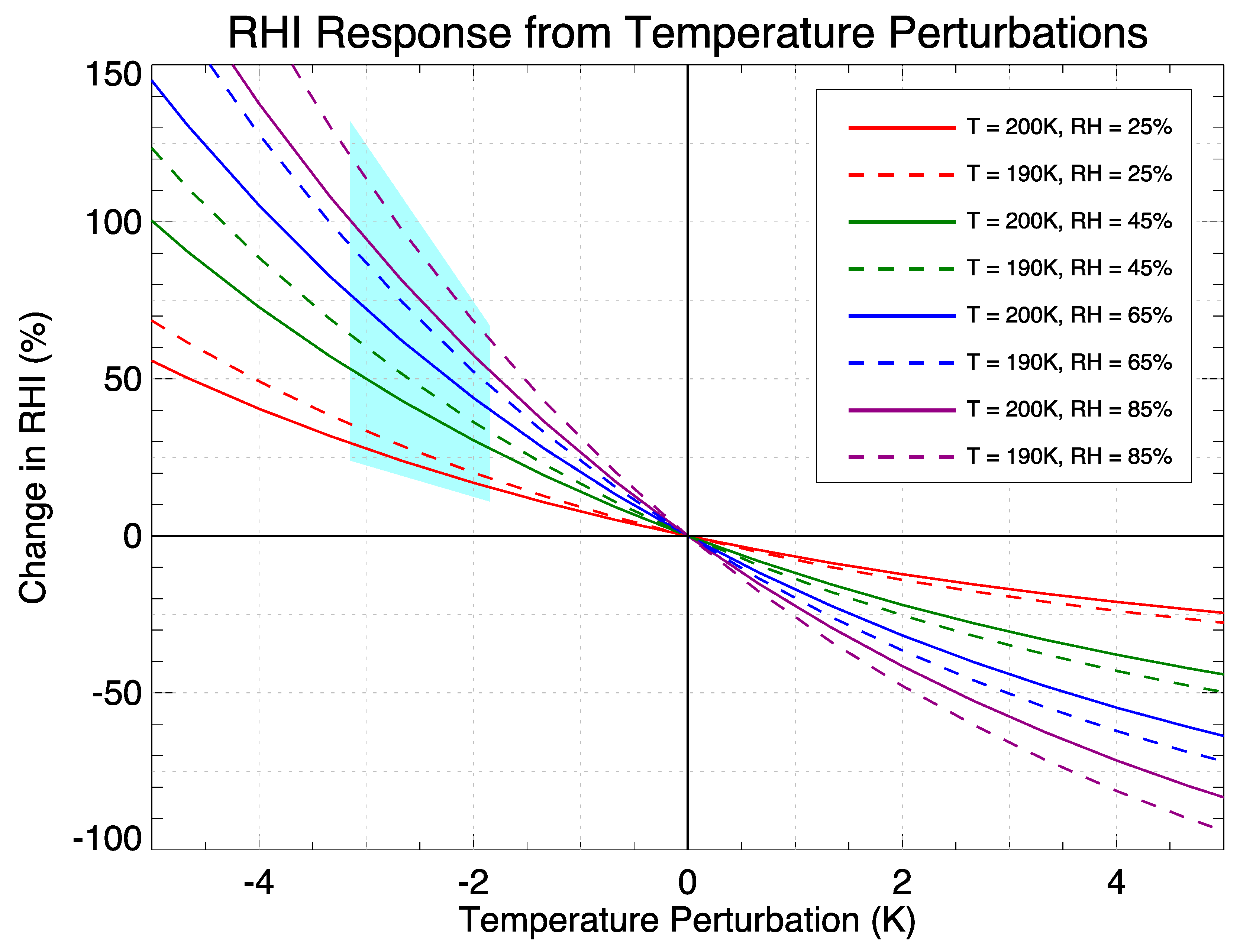The Influence of Gravity Waves on Ice Saturation in the Tropical Tropopause Layer over Darwin, Australia
Abstract
1. Introduction
- 1.
- When using an atmospheric state classification algorithm (as opposed to traditional seasonal analysis), how do the characteristics of gravity waves vary between convective (monsoon) and non-convective (non-monsoon) states?
- 2.
- Do gravity waves produce a measurable impact on ice saturation in the TTL?
2. Experiments
2.1. Radiosondes
2.2. ARM Best-Estimate Cloud Radiation Product
2.3. Wavelet Analysis
2.4. Atmospheric State Classification
3. Results
4. Discussion
5. Conclusions
Author Contributions
Funding
Acknowledgments
Conflicts of Interest
References
- Chandra, S.; Ziemke, J.R.; Min, W.; Read, W.G. Effects of 1997–1998 El Nino on tropospheric ozone and water vapor. Geophys. Res. Letts. 1998, 25, 3867–3870. [Google Scholar] [CrossRef]
- Ploeger, F.; Konopka, P.; Müller, R.; Fueglistaler, S.; Schmidt, T.; Manners, J.C.; Grooß, J.-U.; Günther, G.; Forster, P.M.; Riese, M. Horizontal transport affecting trace gas seasonality in the Tropical Tropopause Layer (TTL). J. Geophys. Res. 2012, 117, D09303. [Google Scholar] [CrossRef]
- Solomon, S.; Rosenlof, K.H.; Portmann, R.W.; Daniel, J.S.; Davis, S.M.; Sanford, T.J.; Plattner, G.K. Contributions of stratospheric water vapor to decadal changes in the rate of global warming. Science 2010, 327, 1219–1223. [Google Scholar] [CrossRef] [PubMed]
- Fueglistaler, S.; Dessler, A.E.; Dunkerton, T.J.; Folkins, I.; Fu, Q.; Mote, P.W. Tropical tropopause layer. Rev. Geophys. 2009, 47, RG1004. [Google Scholar] [CrossRef]
- Holton, J.R.; Gettelman, A. Horizontal transport and the dehydration of the stratosphere. Geophys. Res. Letts. 2001, 28, 2799–2802. [Google Scholar] [CrossRef]
- Jensen, E.J.; Toon, O.B.; Pfister, L.; Selkirk, H.B. Dehydration of the upper troposphere and lower stratosphere by subvisible cirrus clouds near the tropical tropopause. Geophys. Res. Letts. 1996, 23, 825–828. [Google Scholar] [CrossRef]
- Hartmann, D.L.; Holton, J.R.; Fu, Q. The heat balance of the tropical tropopause, cirrus, and stratospheric dehydration. Geophys. Res. Letts. 2001, 28, 1969–1972. [Google Scholar] [CrossRef]
- Potter, B.; Holton, J. The Role of Monsoon Convection in the Dehydration of the Lower Tropical Stratosphere. J. Atmos. Sci. 1995, 52, 1034–1050. [Google Scholar] [CrossRef]
- Vincent, R.A.; Allen, S.J.; Eckermann, S.D. Gravity-wave parameters in the lower stratosphere. In Gravity Wave Processes; Springer: Berlin/Heidelberg, Germany, 1997; pp. 7–25. [Google Scholar]
- Fritts, D.C.; Alexander, M.J. Gravity wave dynamics and effects in the middle atmosphere. Rev. Geophys. 2003, 41, 1003. [Google Scholar] [CrossRef]
- Fan, J.; Comstock, J.M.; Ovchinnikov, M.; McFarlane, S.A.; McFarquhar, G.; Allen, G. Tropical anvil characteristics and water vapor of the tropical tropopause layer: Impact of heterogeneous and homogeneous freezing parameterizations. J. Geophys. Res. 2010, 115, D12201. [Google Scholar] [CrossRef]
- Dinh, T.; Podglajen, A.; Hertzog, A.; Legras, B.; Plougonven, R. Effect of gravity wave temperature fluctuations on homogeneous ice nucleation in the tropical tropopause layer. Atmos. Chem. Phys. 2016, 16, 35–46. [Google Scholar] [CrossRef]
- Woods, S.; Lawson, R.P.; Jensen, E.; Bui, T.P.; Thornberry, T.; Rollins, A.; Pfister, L.; Avery, M. Microphysical properties of tropical tropopause layer cirrus. J. Geophys. Res. 2018, 123, 6053–6069. [Google Scholar] [CrossRef]
- Schoeberl, M.; Dessler, A.; Ye, H.; Wang, T.; Avery, M.; Jensen, E. The impact of gravity waves and cloud nucleation threshold on stratospheric water and tropical tropospheric cloud fraction. Earth Space Sci. 2016, 3, 295–305. [Google Scholar] [CrossRef]
- Schoeberl, M.R.; Jensen, E.J.; Woods, S. Gravity waves amplify upper tropospheric dehydration by clouds. Earth Space Sci. 2015, 2, 485–500. [Google Scholar] [CrossRef]
- Jensen, E.J.; Ueyama, R.; Pfister, L.; Bui, T.V.; Alexander, M.J.; Podglajen, A.; Hertzog, A.; Woods, S.; Lawson, R.P.; Kim, J.-E.; et al. High-frequency gravity waves and homogeneous ice nucleation in tropical tropopause layer cirrus. Geophys. Res. Lett. 2016, 43, 6629–6635. [Google Scholar] [CrossRef]
- Thornberry, T.D.; Rollins, A.W.; Avery, M.A.; Woods, S.; Lawson, R.P.; Bui, T.V.; Gao, R.-S. Ice water content-extinction relationships and effective diameter for TTL cirrus derived from in situ measurements during ATTREX 2014. J. Geophys. Res. Atmos. 2017, 122, 4494–4507. [Google Scholar] [CrossRef]
- Kley, D.; Schmeltekopf, A.L.; Kelly, K.; Winkler, R.H.; Thompson, T.L.; McFarland, M. Transport of water through the tropical tropopause. Geophys. Res. Letts. 1982, 9, 617–620. [Google Scholar] [CrossRef]
- Corti, T.; Luo, B.P.; De Reus, M.; Brunner, D.; Cairo, F.; Mahoney, M.J.; Martucci, G.; Matthey, R.; Mitev, V.D.; Santos, F.H.; et al. Unprecedented evidence for deep convection hydrating the tropical stratosphere. Geophys. Res. Letts. 2008, 35, L10810. [Google Scholar] [CrossRef]
- Kim, J.-E.; Alexander, M.J. Direct impacts of waves on tropical cold point tropopause temperature. Geophys. Res. Letts. 2015, 42, 1584–1592. [Google Scholar] [CrossRef]
- Evans, S.M.; Marchand, R.T.; Ackerman, T.P.; Beagley, N. Identification and analysis of atmospheric states and associated cloud properties for Darwin, Australia. J. Geophys. Res. 2012, 117, D06204. [Google Scholar] [CrossRef]
- Turner, D.D.; Ellingson, R.G. The Atmospheric Radiation Measurement (ARM) Program: The First 20 Years; American Meteorological Society: Boston, MA, USA, 2017. [Google Scholar]
- Miloshevich, L.M.; Vömel, H.; Whiteman, D.N.; Leblanc, T. Accuracy assessment and correction of Vaisala RS92 radiosonde water vapor measurements. J. Geophys. Res. 2009, 114, D11305. [Google Scholar] [CrossRef]
- Wang, J.; Zhang, L.; Dai, A.; Immler, F.; Sommer, M.; Vömel, H. Radiation dry bias correction of Vaisala RS92 humidity data and its impacts on historical radiosonde data. J. Atmos. Ocean. Technol. 2013, 30, 197–214. [Google Scholar] [CrossRef]
- Dzambo, A.M.; Turner, D.D.; Mlawer, E.J. Evaluation of two Vaisala RS92 radiosonde solar radiative dry bias correction algorithms. Atmos. Meas. Tech. 2016, 9, 1613–1626. [Google Scholar] [CrossRef]
- Geller, M.A.; Gong, J. Gravity wave kinetic, potential, and vertical fluctuation energies as indicators of different frequency gravity waves. J. Geophys. Res. 2010, 115, D11111. [Google Scholar] [CrossRef]
- Podglajen, A.; Hertzog, A.; Plougonven, R.; Legras, B. Lagrangian temperature and vertical velocity fluctuations due to gravity waves in the lower stratosphere. Geophys. Res. Lett. 2016, 43, 35433553. [Google Scholar] [CrossRef]
- Atmospheric Radiation Measurement (ARM) User Facility. ARM Best Estimate Data Products (ARMBEATM); Xie, S., Chen, X., Eds.; Tropical Western Pacific (TWP) Central Facility: Darwin, Australia, 2008; updated hourly. [Google Scholar] [CrossRef]
- Torrence, C.; Compo, G.P. A practical guide to wavelet analysis. Bull. Amer. Meteorol. Soc. 1998, 79, 61–78. [Google Scholar] [CrossRef]
- Allen, S.J.; Vincent, R.A. Gravity wave activity in the lower atmosphere: Seasonal and latitudinal variations. J. Geophys. Res. 1995, 100, 1327–1350. [Google Scholar] [CrossRef]
- Moffat-Griffin, T.; Colwell, S.R. The characteristics of the lower stratospheric gravity wavefield above Halley (75° S, 26° W), Antarctica, from radiosonde observations. J. Geophys. Res. 2017, 122, 8998–9010. [Google Scholar] [CrossRef]
- Simmons, A.; Uppala, S.; Dee, D.; Kobayashi, S. ERA-Interim: New ECMWF reanalysis products from 1989 onwards. ECMWF Newsl. 2007, 110, 25–35. [Google Scholar]
- Hamilton, K. Climatological statistics of stratospheric inertia-gravity waves deduced from historical rocketsonde wind and temperature data. J. Geophys. Res. 1991, 96, 20831–20839. [Google Scholar] [CrossRef]
- John, S.R.; Kumar, K.K. TIMED/SABER observations of global gravity wave climatology and their interannual variability from stratosphere to mesosphere lower thermosphere. Clim. Dyn. 2012, 39, 1489–1505. Available online: https://doi-org.ezproxy.library.wisc.edu/10.1007/s00382-012-1329-9 (accessed on 21 November 2019). [CrossRef]
- Murphy, D.M.; Koop, T. Review of the vapour pressures of ice and supercooled water for atmospheric applications. Quarterly Journal of the Royal Meteorological Society: A journal of the atmospheric sciences. Appl. Meteorol. Phys. Oceanogr. 2005, 131, 1539–1565. [Google Scholar]




| Atmospheric State | OLR (W/m2) | High Cloud Fraction (%) | KE (J/kg) | PE (J/kg) | Wave Energy (J/kg) | Ratio of KE to PE |
|---|---|---|---|---|---|---|
| 1 | 285.4 | 41.3 | 10.3 | 10.9 | 21.2 | 0.94 |
| 2 | 294.1 | 28.7 | 10.4 | 8.7 | 19.1 | 1.19 |
| 3 | 307.3 | 23.3 | 9.6 | 8.2 | 17.9 | 1.17 |
| 4 | 296.5 | 34.9 | 9.9 | 8.5 | 18.4 | 1.16 |
| 5 | 289.8 | 44.8 | 9.7 | 10.4 | 20.1 | 0.93 |
| 6 | 295.2 | 42.0 | 9.1 | 8.9 | 17.9 | 1.02 |
| 7 | 271.6 | 88.3 | 11.5 | 15.0 | 26.5 | 0.77 |
| 8 | 280.4 | 73.0 | 9.6 | 12.2 | 21.8 | 0.79 |
© 2019 by the authors. Licensee MDPI, Basel, Switzerland. This article is an open access article distributed under the terms and conditions of the Creative Commons Attribution (CC BY) license (http://creativecommons.org/licenses/by/4.0/).
Share and Cite
Dzambo, A.M.; Hitchman, M.H.; Chang, K.-W. The Influence of Gravity Waves on Ice Saturation in the Tropical Tropopause Layer over Darwin, Australia. Atmosphere 2019, 10, 778. https://doi.org/10.3390/atmos10120778
Dzambo AM, Hitchman MH, Chang K-W. The Influence of Gravity Waves on Ice Saturation in the Tropical Tropopause Layer over Darwin, Australia. Atmosphere. 2019; 10(12):778. https://doi.org/10.3390/atmos10120778
Chicago/Turabian StyleDzambo, Andrew M., Matthew H. Hitchman, and Kai-Wei Chang. 2019. "The Influence of Gravity Waves on Ice Saturation in the Tropical Tropopause Layer over Darwin, Australia" Atmosphere 10, no. 12: 778. https://doi.org/10.3390/atmos10120778
APA StyleDzambo, A. M., Hitchman, M. H., & Chang, K.-W. (2019). The Influence of Gravity Waves on Ice Saturation in the Tropical Tropopause Layer over Darwin, Australia. Atmosphere, 10(12), 778. https://doi.org/10.3390/atmos10120778





